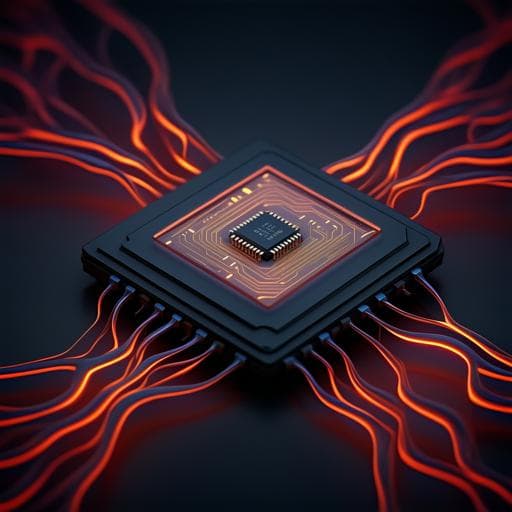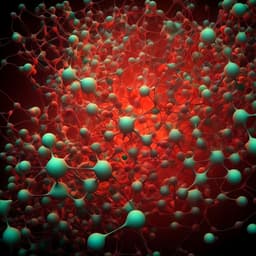
Medicine and Health
Fully implanted battery-free high power platform for chronic spinal and muscular functional electrical stimulation
A. Burton, Z. Wang, et al.
Explore groundbreaking research on electrical stimulation of the neuromuscular system, revealing a passive resonator-optimized power transfer design that achieves ±20 V and >300 mW. This innovative work by Alex Burton and colleagues demonstrates multichannel, biphasic, and current-controlled operation in freely behaving animals, showcasing functionality over 6 weeks in rats. Unlock the potential for advanced muscle stimulation applications!
~3 min • Beginner • English
Introduction
Electrical stimulation of the central and peripheral nervous systems is widely used to restore or modulate function (e.g., cochlear implants, deep brain stimulation) and is increasingly explored for rehabilitation by enhancing neuroplasticity. A key obstacle is delivering and sustaining sufficient power, particularly at higher voltages and currents, over extended periods. Batteries in human and preclinical small-animal studies impose size, maintenance, and behavioral constraints; wired tethers increase infection risk, scarring, displacement, and restrict activity, hindering evaluation of continuous stimulation protocols lasting days to weeks. Near-field wireless power transfer (WPT) offers a battery-free alternative but typically suffers from limited harvested power due to coupling and inductance trade-offs, constraining operational voltage and power. Flexible, biocompatible, wirelessly powered implants can improve comfort and longevity, yet most battery-free systems provide unregulated voltage control and limited programmability; current-controlled, multichannel systems often rely on costly ASICs with limited generalizability. Diverse targets (spinal cord, peripheral nerve, muscle) demand very different current and voltage ranges, from microamps for intraspinal stimulation to milliamps for intramuscular stimulation, with electrode impedances spanning milliohms to tens of kiloohms, often requiring voltages up to tens of volts. Existing devices generally cannot cover both low and high ranges simultaneously for multi-site stimulation. To address these gaps, the authors present a fully implantable, flexible, battery-free device delivering up to ±20 V, current-controlled stimulation from 40 µA to 4.7 mA, and independent programming across 8 channels, enabled by a passive resonator-based WPT scheme that enhances harvested power at practical voltages. The platform integrates off-the-shelf components on a stretchable, conformal substrate, supports digital control and telemetry, and demonstrates chronic operation with minimal behavioral impact in freely moving rats, including spinal cord injured animals. The study evaluates design, power transfer efficiency, electrical performance, mechanical reliability, safety, and functional outcomes over up to 6 weeks.
Literature Review
The paper situates the work within prior neuromodulation therapies (cochlear implants, DBS) and rehabilitation paradigms leveraging neuroplasticity. It highlights limitations of battery-powered and wired systems in chronic preclinical studies, and constraints of conventional 2-coil near-field WPT where harvested power and maximum power point voltage depend on inductance and coupling, creating a trade-off that limits usable power at required voltages. Prior flexible, wirelessly powered devices improved biocompatibility and longevity but often used unregulated voltage or simple programming; current-controlled multichannel designs typically required custom ASICs, reducing flexibility and increasing cost. Reported current requirements vary substantially across targets: intraspinal (sub-µA to tens of µA), epidural spinal (tens to hundreds of µA), and intramuscular (mA), with electrode impedances necessitating voltages from mV to tens of volts. Earlier systems struggled to span these ranges simultaneously for multichannel, multi-site FES. The authors leverage concepts from strongly coupled magnetic resonance (SCMR) WPT to integrate a passive resonator with the receiver, expected to enhance coupling, misalignment tolerance, and bandwidth compared to traditional 2-coil systems, and to improve harvested power without impractically high maximum power point voltages.
Methodology
Device design and fabrication: A monolithic, dual-sided flexible printed circuit (100 µm thick; two rolled-annealed copper layers separated by polyimide) was designed in AutoCAD and panel-fabricated. Copper traces were nickel-activated and brush gold plated at electrode sites. Off-the-shelf components were assembled using low-temperature solder and reflowed; the microcontroller (Atmel ATtiny84A) was programmed via a custom ISP board. The implant integrates separate rigid islands for ICs connected by self-similar serpentine interconnects to isolate strain. A co-planar receiver antenna and an on-device passive resonator were patterned on opposite sides of the implant.
Encapsulation: Components were potted with thermal epoxy, then conformally coated with Parylene-C (total ~18 µm) followed by a platinum-cure silicone overcoat. Devices were bench-tested pre- and post-encapsulation for two-way communication and stimulation in saline.
Wireless power and communication: Power was delivered at 13.56 MHz using an instrumented enclosure with a 2-turn transmitter antenna (56 cm × 16 cm; turn spacing 4 cm). The implant employed a co-located passive resonator with the receiver (3-coil SCMR topology) to enhance coupling and lower the maximum power point voltage. A center-tapped receiver with two half-bridge rectifiers generated dual supplies (± up to 20 V) without DC/DC conversion. ASK modulation of the RF carrier programmed the device (3 bits parameter select, 8 bits value). Telemetry used infrared (IR) transmission for supply voltage, electrode voltage, impedance, and fault status.
Stimulation electronics: A low-power microcontroller controlled an 8-bit DAC and an analog multiplexer to direct a precision current driver to up to 8 channels with independent parameters. Configurable dynamic ranges included ±4.7 mA (40 µA resolution) or ±1.8 mA (7 µA resolution via feedback resistor changes). Biphasic, current-controlled pulses supported active charge balancing.
Antenna characterization and simulation: Antenna designs (4-turn, 8-turn, and co-planar 4-turn with resonator) were simulated (Ansys Electronics Desktop/Simplorer) for coupling, efficiency, and maximum power point voltage and measured with VNA (S11/S21). Spatial power maps and angular misalignment tolerance were assessed within the cage at RF powers of 2–6 W. Bending sensitivity was tested using fixtures (radii down to 2 cm).
Power/thermal measurements: Harvested power versus load and position was recorded at multiple RF powers; device current consumption was measured across operating conditions. Thermal rise was measured with thermocouples and simulated (ANSYS) using component power dissipation to ensure <1 °C surface temperature increases in saline.
Mechanical design and testing: Finite element analyses (Ansys) evaluated elastic strain in copper traces of serpentine interconnects under physiological displacements inferred from µCT of implanted devices. Benchtop tests validated strain profiles, tensile limits, and fatigue life (>1.5 million cycles) while monitoring trace impedance. Failure loads and maximum strains were quantified for spinal and return electrode interconnects.
Electrode testing: Spinal (200 µm diameter Au microelectrodes) and intramuscular (braided PTFE-coated stainless steel with crimped stainless-steel tube) electrodes were characterized in PBS: impedance spectra (10 Hz–10 kHz), current accuracy tests with resistive loads (1–16.5 kΩ), voltage compliance up to ±20 V, and ex vivo charge balance (integrated residual charge). Accelerated lifetime tests probed operation within and beyond the gold water window (±0.2–±1.2 V; and ±1.4 V) at 1 kHz, 100% duty cycle over 14 days.
Animal procedures: Female Sprague–Dawley rats (250–350 g) underwent subdermal implantation of device body over the lumbar spine; spinal electrodes were inserted epidurally via partial laminectomy (L3–L4) and anchored to vertebral screws; intramuscular electrodes were tunneled to biceps femoris posterior. Perioperative analgesia and care adhered to IACUC approvals. In some subjects, complete midthoracic transection (T10) was performed after implant verification. Device locations were monitored with X-ray; µCT provided 3D reconstructions to assess device conformation and interconnect routing.
Behavioral and functional testing: Spontaneous exploration (30 min sessions) and treadmill locomotion (10 cm/s, 200 fps video) were tracked with DeepLabCut to assess post-implant recovery and kinematics. Under anesthesia, recruitment curves were obtained for each channel by incrementing current; toe displacement quantified evoked responses. In awake animals (including SCI), stimulation-evoked hindlimb movements were recorded during treadmill locomotion and in-cage sessions. Telemetry synchronized system voltage compliance and stimulation timing with positional tracking. Chronic stability was assessed by weekly testing over up to 6 weeks and by extended continuous stimulation sessions (6 h) in home cages.
Key Findings
- Wireless power transfer: Integrating an on-device passive resonator (3-coil SCMR) increased simulated/measured transmission efficiency versus a 2-coil system (e.g., from ~12% to ~37%). Comparable efficiency with an 8-turn receiver in 2-coil systems would require impractically high maximum power point voltages; the resonator maintained practical voltages while boosting harvested power.
- Harvested power and voltage compliance: In a 56 cm × 16 cm enclosure, minimum harvested power in the center was ~120 mW at ±20 V compliance (2 kΩ load) with 2 W RF input. With 6 W RF, up to ~325 mW was harvested at the implant. Using 4 W RF, the system harvested ~250 mW versus ~50 mW reported in a prior similar-size receiver design, a >500% improvement in power density (from 5.71 mW/cm² to 31.25 mW/cm²). Devices supported dual supplies up to ±20 V across the arena (±4 V variation at 10 kΩ load; 5 W RF).
- Misalignment and bending tolerance: For 51 mW average operation at 2 W RF, devices tolerated angular misalignment up to ~54.4°. At 5 W RF, tolerance increased to ±75.3°. Bending to a radius of ~3.4 cm reduced harvested power by ~20%, compensated by increased RF power if needed.
- Thermal safety: Surface temperature rise in saline remained <0.8 °C at RF inputs up to 6 W, meeting safety guidelines.
- Power consumption: Average device currents were ~2.5 mA at startup and ~3.3 mA during stimulation at ±20 V supplies due to efficient step-down regulation and low microcontroller clock rate.
- Stimulation performance: Eight independently addressable channels with biphasic, current-controlled pulses. Dynamic range configurable up to ±4.7 mA with 40 µA steps (±1.8 mA range with 7 µA steps). Current accuracy error ~±12 µA at 1 mA (DAC ±7 µA, driver ±5 µA). Multiplexer switching latency ~40 µs. Active charge balancing yielded residual charge ≤4.6 nC during 1.8 mA biphasic pulses at 87 Hz.
- Electrode stability: Intramuscular electrodes showed stable impedance and appearance within/above water window. Spinal Au microelectrodes increased impedance by <15 kΩ within water window over 14 days (~>1 billion pulses equivalent at 50 Hz); above ±1.4 V, dissolution and failure occurred by 7 days. Accelerated lifetime spinal stimulation (1 mA, 1000 Hz, 9 million pulses) showed degradation comparable to literature.
- Mechanics and durability: Self-similar serpentine interconnects maintained elastic strain (simulated maxima ~0.77% for spinal lead insertion; ~2% for return lead elongation), withstanding >1.5 million strain cycles without conductivity loss. Maximum strains before failure: spinal interconnect ~311% (56 mm displacement); return interconnect ~330% (140 mm), far exceeding surgical/physiological demands.
- Behavioral impact: Implanted devices were subdermal and conformal; animals were visually indistinguishable from naïve by week 2. In-cage exploration decreased the first week post-surgery but returned to baseline by week 2 (n=4; repeated measures ANOVA, Bonferroni-corrected p≈0.004 for week 1 vs baseline). Treadmill hindlimb range of motion pre- vs post-implantation showed minimal changes (n=2).
- Functional outcomes: In anesthetized and awake animals (including complete SCI at T10), stimulation of spinal and muscle sites produced graded, controlled hindlimb movements. Recruitment curves scaled with current: spinal sites typically ~10 µA to 1 mA (≈200 µA typical) and muscle sites ~1–5 mA (≈2 mA typical), with temporal control producing twitches to tetanus (4–100 Hz). X-ray fiducials mapped rostral sites to flexion and caudal to extension.
- Chronic stability: Devices remained functional 4–6 weeks. Weekly recruitment curves were largely consistent; average threshold current change ~0.067 mA over 4 weeks. Spinal electrode position drift was minimal over one month (mean absolute rostrocaudal displacement 0.5 ± 0.6 mm; rotation 0.8 ± 0.5°).
- Free-behavior reliability: In-cage 2 h session (282 µA, 114 µs, every 10 s): 694/694 events compliant; average system voltage 15.3 ± 2.5 V. On treadmill (same parameters, larger enclosure): average 12.7 ± 1.0 V; 52/219 events noncompliant, but stimulation still delivered with slightly reduced current. Two 6 h continuous sessions (days 25 and 28 post-implant) showed average system voltages 16.2 ± 2.4 V and 15.8 ± 2.8 V with only intermittent drops. Larger enclosures reduced compliance voltage but still supported high-voltage stimulation (e.g., 9.9 ± 2.8 V).
Discussion
The integrated passive resonator SCMR topology addresses the central challenge of providing sufficient harvested power at practical voltages for chronic, multi-site FES in small freely moving animals. By boosting coupling without forcing high maximum power point voltages, the platform delivers dual ±20 V supplies and hundreds of milliwatts in typical arenas, enabling current-controlled, biphasic, multichannel stimulation across tissues with widely varying impedance and current demands. Digital programmability and telemetry allow real-time monitoring and parameter adjustment, supporting complex protocols and ensuring safety (e.g., detecting noncompliance or faults). Mechanical design with self-similar serpentine interconnects and soft encapsulation maintains elastic operation over repeated strain cycles while minimizing tissue irritation, yielding stable implant positioning and minimal behavioral impact after recovery. Functional tests in intact and SCI rats demonstrate robust, graded recruitment from both spinal and muscle sites over weeks, with recruitment curves largely stable and device power margins adequate across behaviors. Variability in awake spinal responses likely reflects physiological state changes rather than device limitations. Collectively, the results establish a general, cost-effective, battery-free platform suitable for chronic neuromodulation studies requiring uninterrupted, high-power, high-compliance stimulation in freely moving small animals.
Conclusion
This work presents a fully implantable, flexible, battery-free FES platform that combines on-device passive resonator-enhanced wireless power transfer with dual-supply, multichannel, current-controlled biphasic stimulation and bidirectional telemetry. It achieves up to ±20 V compliance, >300 mW harvested power, and precise current delivery (down to tens of µA resolution) across eight channels, outperforming prior systems (~500% higher harvested power density) while maintaining thermal and mechanical safety. The devices operate stably for at least 4–6 weeks with minimal impact on animal behavior and reliably evoke graded hindlimb movements from both spinal and muscle targets, including in spinal cord–transected rats. The platform leverages standard flexible PCB manufacturing and off-the-shelf components, enabling scalable, single-use deployment for chronic rodent studies. Future directions include expanding chronic validation across broader paradigms and durations, optimizing encapsulation for longer lifetimes, and translating to larger animals or human applications via wearable, directed power delivery solutions that address increased Tx–Rx distances.
Limitations
- Device lifetime: Encapsulation accelerated testing (Arrhenius scaling) estimated ~3 months at 37 °C; in vivo devices generally remained functional for 4–6 weeks. Longer-term stability may require improved encapsulation and electrode materials.
- Electrode materials: Gold spinal microelectrodes remained stable within the water window but failed when driven beyond ±1.4 V, limiting permissible stimulation margins; alternative materials (e.g., Pt) could extend safe operation.
- Power coverage: Voltage compliance decreases in larger enclosures and under severe misalignment or bending; higher RF drive mitigates but increases energy use. Some noncompliant events occurred on larger treadmill setups, though stimulation still occurred with slightly reduced current.
- Generalizability: Full characterization across diverse behaviors, electrode types, and chronic time scales beyond 6 weeks was limited; additional studies are needed to comprehensively assess long-term performance.
- Translation to larger species: Magnetic resonant coupling efficiency declines with Tx–Rx distances >1 m; wearable or body-proximal transmitters are needed for large animals/humans and require further development.
Related Publications
Explore these studies to deepen your understanding of the subject.







